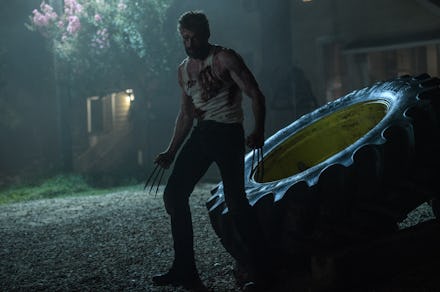'Logan' review: New Wolverine movie hits a little too close to home

The third and final installment of Marvel's Wolverine origin series, Logan, directed by James Mangold, premiered Friday night at the Berlinale, or the Berlin International Film Festival. It's an anachronous headliner at a festival that also included the premieres of an unexpected sequel to Trainspotting and a 105-minute beachfront Stellan Skarsgard picture (Return to Montauk), but Logan holds its own, artistically, as the sort of superhero movie that feels uniquely suited to the international moment.
Logan opens on rock bottom for our hero — in Logan's case, sleeping in the back of the Chrysler limousine he's been driving for a ride-sharing company around El Paso. It's 2029, and the world looks largely the same, with a few significant advancements in the margins — self-driving tractor-trailers, for example, and reference to "the fence" along the border. Mutants have been eradicated insofar as no more have been born in the past 25 years. Parts one and two, X-Men Origins: Wolverine (2009) and The Wolverine (2013) were set in 1845 and 1945 respectively, and the third film makes yet another jump of not quite a century, and only 12 years ahead of the year of its release.
Professor Charles Xavier is in hiding at a compound somewhere south of the Texas border, and is living with an unspecified degenerative brain disease — the very brain classified by the U.S. government as a “weapon of mass destruction.” Keeping house for him is Caliban, an albino mutant with the ability to track mutants telepathically. Xavier claims to be communicating with "someone," despite his isolation, which puts both Caliban and Logan on edge.
A woman approaches Logan at a funeral he's driving for asking desperately for his help, but he shoos her away; without saying as much, he seems to have "retired" from mutant-ing, as much as that's possible. Eventually she gets hold of him and says that she needs to get her daughter Laura to North Dakota so she can cross the border into Canada where she’ll be safe.
The general plot is a series of slow reveals, but Laura is one of nearly a dozen "new" mutants, who have become a liability for the corporation that created them, and has since resolved to eradicate them — and so they've headed north.
Watching a group of children — most of them nonwhite — running for the border, pursued by cops in riot gear and armored cars, I was reminded of reports over the past month of refugees fleeing the U.S. for Canada after Trump’s “Muslim ban” executive order.
The notion of a national border as a safe haven seems somehow old-fashioned, as though everything behind the armored onslaught of the pseudo-sci-fi military-corporate complex of the near future — both ideological and scientific, in a world in which mutants exist — could be stopped by something as civil and diplomatic as a national border. But this is precisely the case in our own, mutant-less world — a line on a map can mean life or death for refugees.
Though the movie was reportedly filmed between May and August, Logan's 12-year jump extrapolates a Trumpian America in an alternate mutant semi-present. An oblique throwaway reference by Dr. Zander Rice to "My friend Donald in the States" can be read as either a stiffly constructed reference to Donald Pierce, a cyborg with a distinctly Southern accent involved in the mutant hunt, or The Donald himself, as a characterization of the particular brand of corporate evil Rice practices.
A conspicuous Americanness runs through Logan, so much so that we actually watch Professor Xavier watch several minutes of the 1953 movie Shane, about a lone cowboy in Wyoming fighting moneyed land barons on behalf of ordinary settlers. This parallels Logan's presence in Logan as a kind of lonestar, both by virtue of being in Texas and by the fact that he drives a Chevrolet limousine and two different pickup trucks, one of which is a Ford Bronco.
The assertion, early in the film, that there have been no new mutants born for 25 years suggests a societal cleansing; a radio commentator gripes, "It's 2029, why are we still talking about mutants?" It’s a science-fiction echo of the sort of rhetoric that would suggest racism and sexism have been solved, and that anyone still concerned with their issues is somehow living in the past.
As a superhero movie, Logan functions as cautionary social commentary. Though much of what resonates between Logan and real life has transpired since filming wrapped — the election of Donald Trump as president, the subsequent not-a-ban ban on Muslim immigrants, immigration raids in major cities — the political climate of Logan is uncomfortably familiar.
Logan will be released in theaters on March 3.